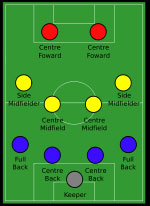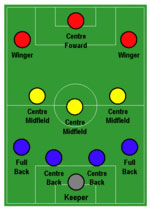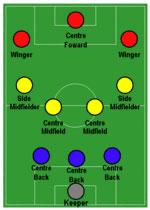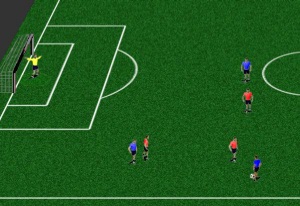How to Play Soccer-The basics, Fundamentals and Essentials
The objective of this article is to outline the basics and fundamentals of the game of soccer. The article will attempt to teach you a little bit on how to play the game of soccer. From fundamentals like passing and shooting, to how many players are on the pitch at one time this article will outline some of the basics. You will find videos, links to other resources for more in depth information.
Who is the "How to play Soccer" resource meant for?
This resource is great for all those that want to increase their knowledge of the basics of the game. If you don't know anything about soccer this is a good place to start. If you are a parent and have kids playing soccer and would like to understand the game a little better this is a good place to start. If you want to refresh your knowledge so that you can help friends, family, kids or anyone understand soccer better this is a good place to start.
The beginning of this article starts with the absolute basics of the game and rules. Later in the article I address soccer formations and other skills like how to kick a soccer ball and pass a soccer ball. If you know the absolute basics like the object of the game keep reading.
With that small introduction let's get this party started and learn "How to Play Soccer."
What is the object of the game?
The object of the game of soccer is to outscore your opponent.
You outscore opponents by kicking the round ball into the opponents
net. ( You won't get more basic than this. Keep
reading! I promise it gets more technical than this.)
Who can touch the ball with their hands?
The only player that can touch the ball with his/her hands is the
Goalie unless you are throwing the ball in. (At this point you
are questioning if it really gets more technical than this. I
promise it does.)
How many players can be on the field from each team?
11 players on the field ( I promise!)
What positions are on a soccer team and what is their role?
-
Goalie-The goalie is the final stop against the other team scoring. They also distribute the ball to all team members from the back. The goalie will usually distribute the ball to the team in one of a few ways: throwing the ball to defenders, kicking the ball deep to around the midfield location, and from the goal kick position, to name a few.
-
Defenders -There are usually 3-4 to a side. There job is to stop the attack and help prevent scoring. They also will help with getting the ball to the midfield. Good defenders are critical in that they will make the goalie's job a lot easier. Good defenders can make a goalie look good.
-
Midfield-There are usually 3-5 midfielders on the field at any one time. They will run the length of field. They will mark other midfield players and distribute ball to forwards. They play defense and offense.
-
Forwards. 1-3 forwards. Their job is to score goals and depending on the philosophy of the coach, provide pressure against the opposing teams defenders with the ball.
What is the size of the soccer pitch?
Dimensions
Here are the rules on the dimensions of the soccer field based on
FIFA regulations.
The field of play must be rectangular. The length of the touch line
must
be greater than the length of the goal line.
Length: The
minimum length of the soccer field is 100 Yards and maximum is 130
yards
Width: The
minimum width of the soccer field is 50 yards and maximum is 100
yards.
International Matches
Length: The minimum length of the soccer field is 110 yds and maximum is 120 yds.
Width: The
minimum width of the soccer field is 70 yds and maximum is 80 yds
What is the duration of a match?
Each match consists of two halves. Each half is 45 minutes in length. The half time cannot exceed 15 minutes in length. The referee can add time to the 45 minutes in each half for: Substitutions, assessment of injury to players, wasting time, removal of injured players from the field of play. The allowance for time lost is at the discretion of the referee.
The game can end in a tie unless otherwise noted. Notable times when a game will not end in a tie are during many championships games where a winner must be declared. For example, the world cup final will not end in a tie. When a winner must be declared to move to the next level of a tournament there will often be overtime if at the end of regulation there is a tie.
What is a Yellow Card?
The best way I can describe a yellow card is that it applies to
players or coaches that acts in a way that is unsporting,
shows dissent, delays the restart of a game, persistently
breaks the laws of the game, commits a semi serious foul etc.
The referee will show the yellow card by lifting it up over his or
her head. Two
yellow cards in a game result in a red card and eventual sending
off.
What is a Red Card?
A red card is shown if the player gets two yellow cards in a single match. A player can also be shown a straight red card if he/she is guilty of a serious foul, violence, spits on opponents, using a hand ball deliberately to stop a scoring opportunity (unless you are the goalie). A red card results in sending off.
How is the game best played?
This is up for debate but let me give you my opinion, which I think most coaches and unselfish players will agree with. The game is best played as a team. When one player ventures off on his/her own this diminishes the power of the team. Let me give you an example. The tendency of the 'ball hog" becomes ball hoarding with every team mate. Ball Hogging, just like unselfish play can become infectious. Players like to touch the ball and shoot the ball etc. If every time a player passes the ball to the ball hog and know they won't get it back this will affect the flow of the game. A ball passed to a ball hog could be like passing to the black hole-the ball will not come out. The unselfish player knows they are not going to get the ball back, so will that unselfish player make the run up the side to get open? NO!
The game needs to be played with passing, give and goes, overlapping runs etc. The only way all of this works is for players to pass the ball and feel like they will get it back when they are open.
My recommendation is to win first. The sum of the parts if greater than one part itself.
1+1+1+1=4 but 1+0=1. Pass the ball dang it. We don't like playing with ball hogs.
What equipment is needed for soccer?
-
Matching uniforms for each team
-
Cleats-Assuming the game is on grass you will need a pair of soccer cleats. If the field is artificial turf a good turf shoe will do.
-
Shin guards- Shin guards are meant to protect the shin in case of potential harming kicks. Usually large socks are pulled over the shin guards.
-
Soccer Ball-Round and of a circumference of not more than 70cm and not less than 68 cm.
Help me understand the basic Soccer formations
Permission to use below information given by Wikipedia via the GNU Free Documentation License. Click here to read the permission. For the Copyright notice and description of permission for readers of this website to use the information from Wikipedia please Click here.
4-4-2 Soccer Formation

The 4-4-2 is the most common is soccer today. It is so well known that they even named a magazine after it. In this formation the midfielders must work hard to support both the attack and the defense. One of the central midfielders is expected to go up field as often as possible to support the forward pair, while the other will play a "holding role". The two midfielders on the outside must move up and down the flanks in the attack and defense. This formation is popular in Britain. (Figure above Copyright http://en.wikipedia.org/wiki/Formation_%28football%29#4-4-2 )
4-3-3 Soccer Formation
 The
4-3-3 formation was played by the Brazilian National team in the
1962 world cup. This formation consists of 4 defenders- Two
center backs, two full backs; 3 midfielders; 1 forward and two
wingers. (Figure above Copyright
http://en.wikipedia.org/wiki/Formation_%28football%29#4-4-2)
The
4-3-3 formation was played by the Brazilian National team in the
1962 world cup. This formation consists of 4 defenders- Two
center backs, two full backs; 3 midfielders; 1 forward and two
wingers. (Figure above Copyright
http://en.wikipedia.org/wiki/Formation_%28football%29#4-4-2)
4-5-1 Soccer Formation
 The 4-5-1
is another defensive scheme. But if the wingers attack more the
formation could be more like the 4-3-3. This formation can be used
to grind out ties or if you have a lead maintain it. The extra
midfield players makes it difficult for opposing teams to build-up
play. Because there is only one striker in the 4-5-1 the
center of the midfield should push forward as well.
Figure above Copyright,
http://en.wikipedia.org/wiki/Formation_%28football%29#4-4-2 )
The 4-5-1
is another defensive scheme. But if the wingers attack more the
formation could be more like the 4-3-3. This formation can be used
to grind out ties or if you have a lead maintain it. The extra
midfield players makes it difficult for opposing teams to build-up
play. Because there is only one striker in the 4-5-1 the
center of the midfield should push forward as well.
Figure above Copyright,
http://en.wikipedia.org/wiki/Formation_%28football%29#4-4-2 )
3-5-2 Soccer Formation
 In
this formation the two wing players are more focused on the attack.
This keeps the central midfielder further back in case of counter
attacks. Because of how the 3-5-2 is used the midfield will
form a W formation. (Figure above Copyright
http://en.wikipedia.org/wiki/Formation_%28football%29#4-4-2 )
In
this formation the two wing players are more focused on the attack.
This keeps the central midfielder further back in case of counter
attacks. Because of how the 3-5-2 is used the midfield will
form a W formation. (Figure above Copyright
http://en.wikipedia.org/wiki/Formation_%28football%29#4-4-2 )
5-3-2 Soccer Formation

This formation has three central defenders (possibly with one acting
as a sweeper.) This system is heavily reliant on the wing-backs
providing width for the team. The two wide full-backs act as
wing-backs. It is their job to work their flank along the full
length of the pitch, supporting both the defense and the attack.
(Figure to the right, Copyright
http://en.wikipedia.org/wiki/Formation_%28football%29#4-4-2 )
3-4-3 Soccer Formation

In the 3-4-3 the midfield players should be in both the attack and defense. Because this formation only has 3 defenders if the opposition gets through the midfield they could have a greater chance to score. This formation is for offensive-oriented teams. (Figure to the right Copyright http://en.wikipedia.org/wiki/Formation_%28football%29#4-4-2 )
How to play the Basic Soccer Fundamentals
How to pass a soccer ball?
Because body positioning is an important part of passing, as you are doing the above passes off the wall, carefully analyze how you are facing in relation to where you are placing the ball. With an inside face or instep pass, the plant foot should be facing the direction you want the pass to go. The passing foot needs to strike the ball solidly. The ankle should be locked and the knee pulled up after the strike. The leg should follow thorough facing the direction you want the pass to go. When using the outside face, the body is turned slightly away from the pass, the ankle is flexible and "snaps" as the pass is made.
How to receive a soccer ball?
In
order to receive a ball well, you should be light on your toes and
gently bouncing on your feet. This enables you to shift directions
quickly and move your body to receive the ball easily. When doing
the above drills practice this technique. Another good activity to
help train you to be light on your feet is jump roping. Do as many
quick, light single jumps as possible. Time yourself for a minute
and see how many you can get. Try to do more every time. When you
get really good you can increase the time.
The element of body position can affect your ability to receive
balls. You need to practice getting your whole body behind the ball
and direct your first touch out of pressure. Even if you have a poor
first touch, at least the ball will go into an area where you can
play it.
How to kick a soccer ball?
To learn how to kick a soccer ball go to Youth Soccer Skills
How to shoot a soccer ball?
Learn how to shoot a soccer ball by going to youth soccer skills.
What does it mean to move without the ball and how does it help the game?
Earlier I talked about how ball hogs are bad for the game. Ball hogs might create more ball hogs or create a diminished desire for other team mates to want to make the runs necessary because when they pass it they know they wont get it back, so why make a run or move off the ball.
Moving off the ball simply means putting yourself into positions on the field so that you can be in position to make the best play possible. In the sense I want to talk about here is specifically players that are in position to receive the ball. Look below how each soccer player is covered. At its most basic level a simple movement off the ball by the top player in this triangle will create a passing lane that will allow the ball to continue moving.
Moving off the ball will create not only passing lanes, but scoring opportunities. If the top player made a quick move towards the goal and the bottom right player with the ball can deliver a quality pass, this could result in a scoring opportunity. (created with CoachFx software)

How to throw in the ball?
First of all, you cannot score a goal by throwing the ball directly into the net. But you can throw the ball to a team mate who will score the goal. You must throw the ball in with two hands. A one handed throw is illegal. The ball must be delivered from behind and over the head. The throw in must come over the head with two hands.
The next important aspect to keep in mind is the feet. Part of of each foot must either be on the the touch line or on the ground outside the touch line.
Finally, the thrower cannot touch the ball again until it has touched another player.
Goal Keeper Fundamentals?
The Goal Keeper's job is to keep the ball from going into the net. Being a great goal keeper requires cat like reflexes with a mix of good decision making and other critical goal keeping fundamentals. Here are some of the goal keeper fundamentals:
-
Ability to distribute the ball correctly out of the back. This means choosing when to kick it deep or throw the ball to a defender. It means having good punting skills so that your kicks go on targets.
-
Ability to catch the soccer ball correctly. This also means making the correct decision as to when to catch the ball or simply punch the ball out of the box.
-
Decision making is important to goalkeeping. As was mentioned above you must decide to punt or throw the ball out of the back. You must also decide to catch the ball or punch the ball away. Here are 5 tips to help goalkeepers make better decisions.
-
Reaction ability-See the play and react.
-
Diving ability-You have to stop the ball don't you. This will be needed.
-
Speed/agility/acceleration- You might be called upon to make a 5-20 yard run to get to the ball before you opponent. This run could be diagonal or straight forward or to the side.
There is obviously a wealth more information about how to play soccer. But I think this will get you started with some of basic stuff. Search the rest of the site for more information.
